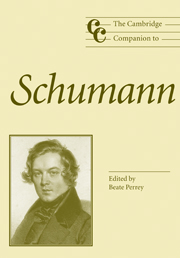Book contents
6 - Why sing? Lieder and song cycles
from Part II - Works
Published online by Cambridge University Press: 28 September 2011
Summary
A story of decades
Song and Schumann are as inextricably linked in the public mind as they are in the minds of performers and musicologists, and this has been the case for roughly a century and a half. It is clear from the history of later nineteenth- and twentieth-century music that Schumann's songs have never gone out of fashion. They seem no more likely to do so than do Mozart's symphonies, or Debussy's piano music. When we are entranced by the experience of a Schumann song we do not need to think about all his other songs: the dominant 13th chord at the end of ‘Morgens steh’ ich auf' (Liederkreis, Op. 24, No. 1) seems to belong to a different universe from the dominant 13th at the end of ‘Die alten, bösen Lieder’ (Dichterliebe, Op. 48, No. 16); even the theorist determined to make connections in the quest for the identification of a musical ‘language’ will note the different context, register, key and so on – a matter of technical comparison such as will be important in the further investigations below. Instead, our cumulative experience of Schumann song is part of the trust that builds up in this repertoire, a belief common already perhaps to most readers of these words that if you happen to encounter one not encountered before, it will be time well spent in a magical world where everything is in its mysterious place.
- Type
- Chapter
- Information
- The Cambridge Companion to Schumann , pp. 102 - 122Publisher: Cambridge University PressPrint publication year: 2007
- 1
- Cited by

